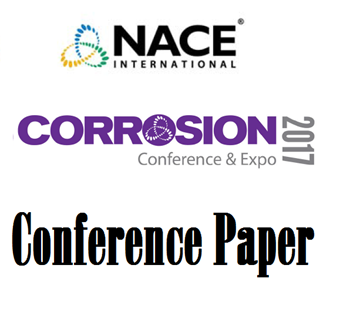Lab-Accelerated Simulation and Maximum Damage Size Assessment of Atmospheric Corrosion of Stainless Steel Compressor Blades Exposed to Marine EnvironmentsJ. Srinivasan and R. G. KellyCenter for Electrochemical Science and Engineering Department of Materials Science and Engineering University of Virginia 395 McCormick Road Charlottesville VA 22904ABSTRACT Compressor blades in jet turbines are often coated with ceramic erosion coatings to protect them from abrasive particles during service. Abrasion results in exposure of the 17-4 PH stainless steel substrate in the earlier compressor stages. In addition use of the engine in marine environments will result in the deposition of sea salt particles. After use the cooling of the engine can result in deliquescence of the salt aerosols creating an environment which can lead to galvanic corrosion of the substrate in the vicinity of the damage as the ceramic coating is often conductive and more noble than the substrate. This corrosion manifests as pits which often are the precursors for fatigue cracks as the blade goes through multiple service cycles [1]. Standard ASTM B117 lab-accelerated atmospheric corrosion testing does not replicate the corrosion morphology observed on bare compressor blades removed from service even after several weeks of exposure. A suitably modified standard atmospheric corrosion testing protocol is therefore necessary in order to assess the corrosion morphology that is expected to develop on blades in service. Accelerated corrosion testing to simulate atmospheric corrosion is achieved by maintaining controlled exposure conditions which are sufficiently aggressive while still remaining representative of the service environment. Current standard accelerated corrosion tests fail to reproduce damage observed in the field unless environmental oxidizers like ozone and UV radiation are introduced in the accelerated corrosion chamber [2 3]. Testing protocols were developed to address two preliminary objectives – i) rapid quantifiable assessment and ranking of erosion coatings with respect to corrosion performance and ii) accelerated corrosion testing involving compact-chamber controlled exposure of bare 17-4 PH compressor blades in the presence of environmental oxidizers to replicate damage observed on blades removed from service. Results from the test protocol developed for ranking erosion coatings led to the formulation of a model erosion coating based on the TixAl1-xN system the industrial standard [4]. Electrochemical testing is ongoing to evaluate the effects of structure and composition of these coatings on corrosion performance. Based on the preliminary accelerated exposure results a modified procedure is being developed which employs two levels of lab-accelerated life testing – i) controlled exposure testing in a compact chamber and ii) cyclic corrosion testing using a modified ASTM G85 A2 standard. The first will permit efficient screening of test variables while the second will allow the translation of the selected variables towards establishing a standard accelerated corrosion test for service blades. Results from this study will be utilized in a predictive analytical model to estimate predict maximum damage size [5] on coated and uncoated metallic surfaces in atmospheric corrosion environments. This estimate can then be used in structural integrity analyses and determination of limiting operating environments and mitigation strategies.AcknowledgmentsFinancial support from the Office of the Undersecretary of Defense Technical Corrosion Collaboration via the USAFA Contract FA7000-10-2-0011 and the Center for Surface Technology Rolls-Royce Corporation Indianapolis IN is gratefully acknowledged. The bare blades were provided by Dr. Sungbo Shim and Dr. Matthew Gold at Rolls-Royce and the PVD coatings were deposited by Dr. Andras Korenyi-Both at Tribologix Inc. Golden CO. Assistance with controlled exposure testing was provided by Piyush Khullar Center for Electrochemical Science and Engineering University of Virginia.References[1] Y. Kondo Corrosion 45 (1989) 7-11.[2] E.B. Neiser Master of Science Thesis University of Virginia Charlottesville 2010.[3] Y. Wan E.N. Macha R.G. Kelly Corrosion 68 (2012) 1-10.[4] L. Swad?ba B. Formanek H.M. Gabriel P. Liberski P. Podolski Surface and Coatings Technology 62 (1993) 486-492.[5] Z.Y. Chen R.G. Kelly Journal of the Electrochemical Society 157 (2010) C69-C78.




